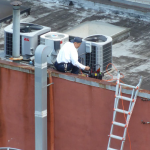NIOSH
Climbing the corporate ladder is usually associated with promotions, salary raises and executive offices. But for many workers, the common metaphor is part of a real-life job description with real-life risks.
Last week, the Centers for Disease Control and Prevention released new data on occupational ladder falls, finding that a fifth — or 20 percent — of all fall injuries among workers involve a ladder. Among construction workers, 81 percent of all fall injuries treated in an emergency department involved a ladder (overall, falls are a leading cause of death in construction). In 2011, CDC…
Labor Secretary Tom Perez announced yesterday a new regulation designed to reduce coal miners’ risk of developing coal mine dust lung disease (CMDLD). I’ve written about these regulations many times, on both the need for them and the snail’s pace at which the White House’s Office of Information and Regulatory Affairs (OIRA) reviewed them. They are long overdue.
Depending on who you ask these new regulations have been in the works since 2009 (beginning of the Obama Administration), 1996 (following an advisory committee report and NIOSH recommendation) or as far back as 1991 (…
I often find myself trying to reconcile a company’s description of its safety program with what I hear from workers. One worker I met summed it up this way:
“Yeah, we have safety talks, but a talk is where it ends. It’s all talk, not real action on safety problems.”
Two recent incidents brought his remark back to life for me. It started with a recent news release from OSHA. The agency announced a proposed penalty of $50,600 to Grede Wisconsin Subsidiaries LLC at the firm’s Browntown, Wisconsin iron foundry. Funny thing is, the firm was touting its safety record last month at OSHA’s…
The National Institute for Occupational Safety and Health (NIOSH) is one of those federal agencies that lies quietly in the background. It’s not one for making waves. It's more like bench scientist who minds her own business in the laboratory. But this week, NIOSH blew its top and created some waves.
In a pointed letter to the head of the USDA’s Food Safety Inspection Service (FSIS), NIOSH director John Howard, MD, said that FSIS was misinterpreting a NIOSH report released last month. The report presents the findings of a NIOSH Health Hazard Evaluation (HHE) performed at a Pilgrim’…
In a February 11th news bulletin, the US Occupational Safety and Health Administration (OSHA) expressed concern “about the alarming increase in preventable injuries and fatalities at communication tower worksites,” and announced it was “increasing its focus on tower safety.” At that point, five weeks into 2014, cell tower work had caused four occupational fatalities for the year – the deaths of three cell tower workers and of one fire fighter. Now, just over a month later, three more cell tower workers have died on the job. On March 19th, a 21-year old from Maryland was killed while working…
Yep. “We’re not stupid” was just one of the many memorable moments at last week’s public hearing on OSHA’s proposed rule on respirable crystalline silica. The remark came from epidemiologist Robert Park of CDC’s National Institute for Occupational Safety and Health (NIOSH). He was compelled to respond to a comment made by Tony Cox, a consultant retained by the American Chemistry Council.
Cox, who was expounding on the OSHA’s peer-reviewed risk assessment, asserted that the agency has not demonstrated a causal link between silica and lung disease at OSHA’s proposed permissible exposure…
This week will mark the next big step in efforts to institute a federal regulation to protect workers who are exposed to respirable crystalline silica. Tuesday, March 18 will be the first of 14 days of testimony and debate about a proposed silica rule which was released in September 2013 by the Occupational Safety and Health Administration’s (OSHA). The “deadly dust” is associated with malignant and non-malignant respiratory diseases and other adverse health conditions. The hazard has been recognized for centuries, but the U.S. does not have a comprehensive rule on the books to protect the…
The billion-dollar poultry industry chews up its workers and spits them out like a chaw of tobacco. One of those workers is in Washington, DC this week to make a plea to the Obama Administration. For 17 years, Salvadora Roman, 59 worked on the de-boning line at a Wayne Farms poultry processing plant in Alabama. The production line ran at an incessant pace that forced her (and her co-workers) to make tens of thousands of repetitive motions on each and every work shift. Her hands and wrists eventually became so swollen and painful that she requested to be moved to a less hand-intensive task.…
As Americans prepare for the Thanksgiving holiday and the White House gets ready for President Obama to pardon the National Thanksgiving Turkey in a Rose Garden ceremony on Wednesday November 27 that will “reflect upon the time-honored traditions of Thanksgiving,” let us take a moment to reflect upon the welfare of the men and women who process the millions of turkeys on their way to Thanksgiving dinners.
First, according to the US Department of Labor’s Bureau of Labor Statistics (BLS), about 220,000 people currently work in the poultry processing industry in the US, at an annual median wage…
The poultry industry must have its head stuck in the chicken coop. With Thanksgiving nearly upon us, the industry is trying to convince the public that poultry-processing plants are great places to earn a living. In just about a week, they’ve issued two written statements insisting they have stellar records on workplace safety. Tom Super, VP of communications for the National Chicken Council, wrote on Nov. 22 at the MeatingPlace blog about recent data from the Bureau of Labor Statistics (BLS) on workplace injury rates. He noted that the case rate for all reportable injuries in illnesses in…
At least 1.7 million US workers are exposed to respirable crystalline silica each year, this according to the National Institute for Occupational Safety and Health (NIOSH). These exposures occur in a variety of industries, among them construction, sandblasting, mining, masonry, stone and quarry work, and in the rapidly expanding method of oil and gas extraction known as hydraulic fracturing or fracking. This exposure can lead to silicosis, an irreversible, and sometimes fatal, lung disease that is only caused by inhaling respirable silica dust. Silica exposure also puts exposed…
A marriage of public health science and civil rights is one way to describe the lifework of John Froines, PhD, professor emeritus at UCLA School of Public Health. After a 50-year career in academia and public service, and the untolled contributions from it, Froines was recognized this week by the internationally renowned Collegium Ramazzini.
The nomination letter submitted to the Collegium by his colleagues captures many highlights of Froines’ impact over several decades, such as:
His high-profile role in the 1960’s anti-war and civil rights movements
His position with the Vermont State…
"Es ridículo,” was the reaction of a poultry plant worker when he heard of the USDA's proposal to "modernize" poultry slaughter. The agency's January 2012 proposal (77 Fed Reg 4408) would allow companies to increase assembly line speeds from about 90 to 175 birds per minute, and remove most USDA inspectors from the poultry processing line.
The Obama Administration should have heard the loud and clear opposition from civil rights, food safety, public health and the workers’ safety communities to the USDA’s proposal. When the public comment period closed in May 2012, the Southern Poverty…
While OSHA has never been the most robustly funded federal agency, its efforts and regulatory authority have helped prevent countless deaths, injuries and illnesses on the job. However, recent budget cuts and future budget cut proposals threaten those gains, and it's no stretch to say that worker health and safety hang in the balance.
In a report released in late August by the Center for Effective Government (formerly OMB Watch), author Nick Schwellenbach chronicled what austerity means for OSHA and the workers it protects. To first put the issue and impacts of slashed budgets in broader…
Senator Kirsten Gillibrand introduced last week the Safe Meat and Poultry Act (S. 1502). The bill would require USDA's Food Safety Inspection Service (FSIS) to take new steps to decrease foodborne pathogens, including authority to compel producers to recall contaminated meat and poultry.
The legislative text is 73 pages long, but one short paragraph caught my eye: a provision addressing the serious health and safety hazards to which meat and poultry workers are exposed. It's an issue that we've written about many times (e.g.. here, here, here, here, here, here, here, here,…
As Liz Borkowski noted yesterday, we are following up on a tradition that we started last year to mark Labor Day. We released our second annual review of U.S. occupational health and safety for Labor Day 2013.
Liz explained in her post our objectives in preparing the report. She also highlighted its first section which profiles some of the best research from the year published in both peer-reviewed journals and by non-profit organizations. Here’s a peek at section two of the report on activities at the federal level:
Sequestration and other budget cuts have affected our…
For older workers, the most dangerous occupational move may be getting behind the wheel.
Last Friday, the Centers for Disease Control and Prevention released data showing that among highway transportation incidents, which are the leading cause of occupational death in the country, the highest fatality rates occur among workers ages 65 years old and older. In fact, workers in that age group experienced a fatality rate three times higher than workers ages 18 to 54. The unfortunate trend was seen across industries and occupations and among most demographic groups, according to data published in…
Marshall Turner, 55 and James "Bubba" Rains, 34 were part of an asphalt paving crew, working on I-55 in Crittenden County, Arkansas. On the evening of April 16, 2013, a pick-up truck driven by an Illinois man swerved into the closed-off construction work zone and struck Turner and Rains. Both men were fatally injured.
The Bureau of Labor Statistics reports that, on average, 110 workers are killed each year while working in roadway and highway work zones. In 2011, the most recent year in which data is available, the number of fatalities was 119. Thirteen of the deaths…
When I asked Teresa Schnorr why we should be worried about the loss of a little-known occupational health data gathering program, she quoted a popular saying in the field of surveillance: "What gets counted, gets done."
Schnorr, who serves as director of the Division of Surveillance, Hazard Evaluations and Field Studies at CDC's National Institute for Occupational Safety and Health (NIOSH), was referring to the Adult Blood Lead Epidemiology and Surveillance program (ABLES), a state-based effort that collects and analyzes data on adult lead exposure. For more than two decades, NIOSH has been…
For this Workers' Memorial Week, the National Coalition for Occupational Safety and Health (National COSH) has released "Preventable Deaths: The Tragedy of Workplace Fatalities," a report that tells the stories of six workers killed on the job and promotes solutions to prevent other workers from sharing similar fates. The report notes that in 2011, 4,609 workers were killed, and construction was the deadliest industry sector, with 721 worker fatalities. The report tells the story of one construction worker killed on the job:
One day in April 2009, Orestes Martinez (29) and two co-…


